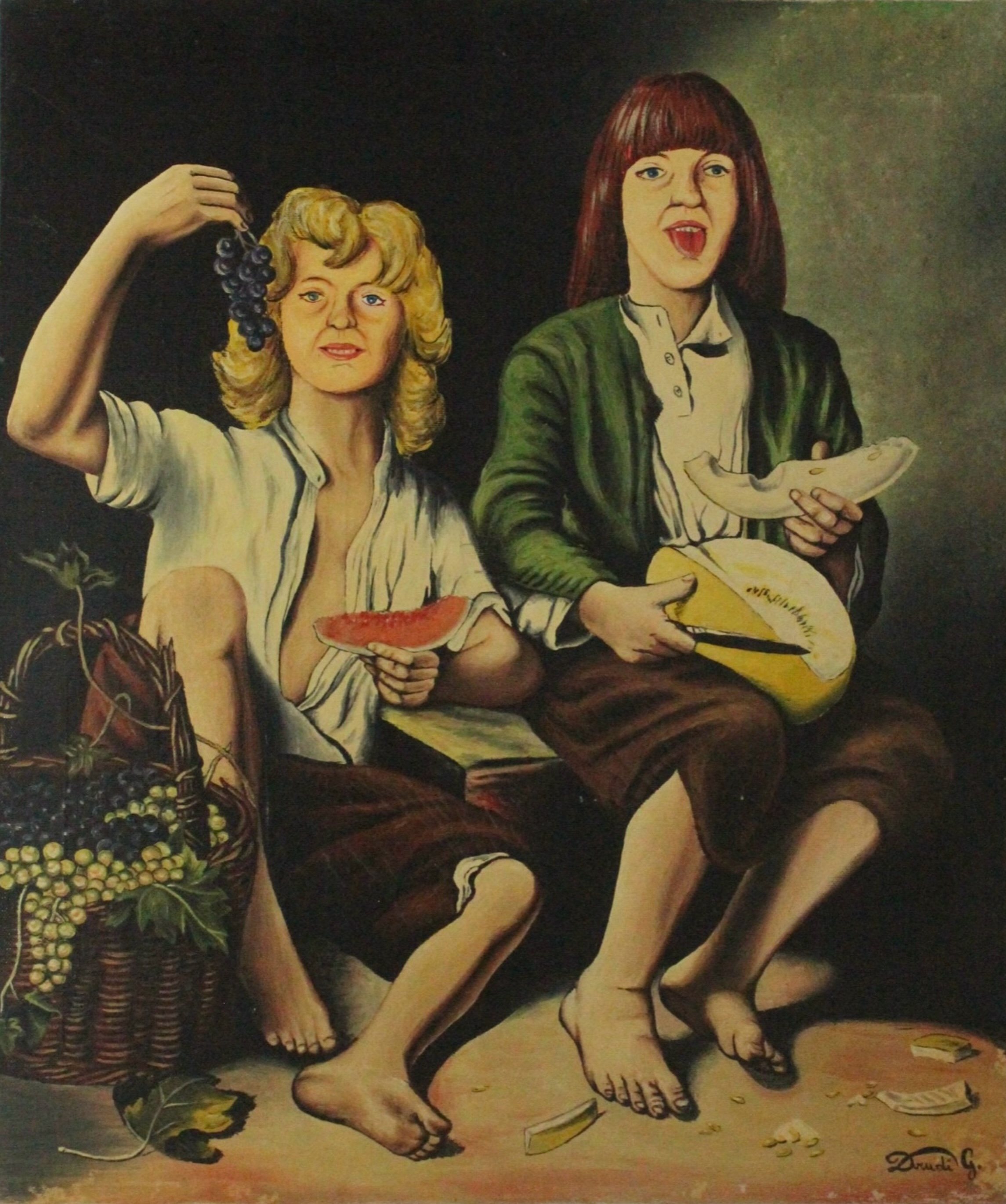FRUIT EATERS
1980, 50x60cm, Glossy oil on canvas

Two peasant twins, a male and a female eating fruit. A work with vivid colors combined with a play of light and shadow. The wicker basket full of white and black grapes represents the prosperity of the seasonal harvest.
“Fruit Eaters,” painted in 1980 with glossy oil on canvas, immortalizes a moment of carefreeness and joy between two young peasant twins, a boy and a girl, intent on enjoying fresh fruit. The artist masterfully uses light and shadow to enhance the expressiveness of the faces and the intensity of the scene, creating a vivid and engaging atmosphere.
Composition and details:
The two youngsters, sitting on the ground barefoot, emanate a sense of genuineness and freedom. The girl, with long blonde curly hair, holds a bunch of dark grapes in one hand and a slice of watermelon in the other, while her brother, with straight red hair, is about to savor a slice of melon with enthusiasm. Their gaze and gestures convey a sense of celebration and abundance, reinforced by the presence of a wicker basket full of white and black grapes next to them. The detail of vine leaves and scattered grape berries on the ground adds a touch of realism, underlining the artist’s attention to the beauty of nature.
Light and shadow:
The play of light and shadow creates depth and volume, highlighting the vivid colors of the fruit and the joyful expressions of the protagonists. The blurred background, which evolves from darker tones to lighter shades, accentuates the sense of three-dimensionality and gives greater emphasis to the scene.
Meaning and interpretation:
This work represents a tribute to the simplicity of peasant life and the beauty of small everyday moments. The spontaneous gesture of the two youngsters enjoying fruit becomes a symbol of genuineness, abundance, and sharing. The choice of fresh fruit – watermelon, melon, and grapes – evokes the connection with the land and the value of the harvest, central elements in rural life.
The artist, through the expressiveness of the characters and the chromatic vivacity, conveys a message of happiness and gratitude for natural resources. The interaction between the two siblings also suggests a sense of complicity and family harmony, in which simplicity becomes a vehicle of affection and authenticity.
Conclusion:
Overall, Fruit Eaters is a work that celebrates joy in small things, transforming an everyday moment into an image of great emotional and visual impact. The skillful use of light and color makes the scene intense and realistic, involving the observer in an almost tangible sensory experience. Through this painting, the artist invites us to rediscover the beauty of nature and the importance of living with simplicity and gratitude.

Two peasant twins, a male and a female eating fruit. A work with vivid colors combined with a play of light and shadow. The wicker basket full of white and black grapes represents the prosperity of the seasonal harvest.
“Fruit Eaters,” painted in 1980 with glossy oil on canvas, immortalizes a moment of carefreeness and joy between two young peasant twins, a boy and a girl, intent on enjoying fresh fruit. The artist masterfully uses light and shadow to enhance the expressiveness of the faces and the intensity of the scene, creating a vivid and engaging atmosphere.
Composition and details:
The two youngsters, sitting on the ground barefoot, emanate a sense of genuineness and freedom. The girl, with long blonde curly hair, holds a bunch of dark grapes in one hand and a slice of watermelon in the other, while her brother, with straight red hair, is about to savor a slice of melon with enthusiasm. Their gaze and gestures convey a sense of celebration and abundance, reinforced by the presence of a wicker basket full of white and black grapes next to them. The detail of vine leaves and scattered grape berries on the ground adds a touch of realism, underlining the artist’s attention to the beauty of nature.
Light and shadow:
The play of light and shadow creates depth and volume, highlighting the vivid colors of the fruit and the joyful expressions of the protagonists. The blurred background, which evolves from darker tones to lighter shades, accentuates the sense of three-dimensionality and gives greater emphasis to the scene.
Meaning and interpretation:
This work represents a tribute to the simplicity of peasant life and the beauty of small everyday moments. The spontaneous gesture of the two youngsters enjoying fruit becomes a symbol of genuineness, abundance, and sharing. The choice of fresh fruit – watermelon, melon, and grapes – evokes the connection with the land and the value of the harvest, central elements in rural life.
The artist, through the expressiveness of the characters and the chromatic vivacity, conveys a message of happiness and gratitude for natural resources. The interaction between the two siblings also suggests a sense of complicity and family harmony, in which simplicity becomes a vehicle of affection and authenticity.
Conclusion:
Overall, Fruit Eaters is a work that celebrates joy in small things, transforming an everyday moment into an image of great emotional and visual impact. The skillful use of light and color makes the scene intense and realistic, involving the observer in an almost tangible sensory experience. Through this painting, the artist invites us to rediscover the beauty of nature and the importance of living with simplicity and gratitude.